How Best to Provide for Your Dog at the Campground
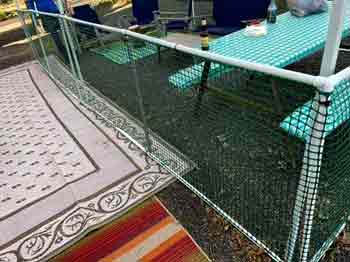
Many new campers are asking how best to provide for their dog at the campsite, as well as campground etiquette for dog ownership. Here are common rules to follow to be a good neighbor, and ways to provide comfort and safety for your pet.
Provide a Safe, Confined Space in the Shade
The magnificent fenced shade area shown above was created by Gerald Grater (but he gives all the credit to his wife). It’s made of PVC tubing and snow fencing put together with zip-ties. Nothing is glued, so it can be taken apart and stored in the camper’s storage locker when not in use. Parts are shown below.
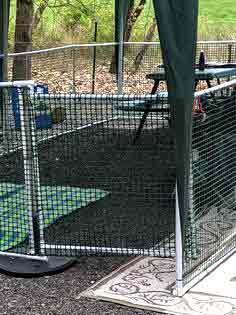 With the 10′ x 20′ Party Tent, Gerald spent about $190.00 for the parts. Assembly takes him roughly an hour.
With the 10′ x 20′ Party Tent, Gerald spent about $190.00 for the parts. Assembly takes him roughly an hour.
He made it at home first. Each section is 5′ long. Then he numbered the pieces so he can easily reassemble it at the campsite.
“The gate is secured with a patio umbrella stand and pole. It needed a sturdy fixture since we aren’t allowed stakes,” Gerald said.
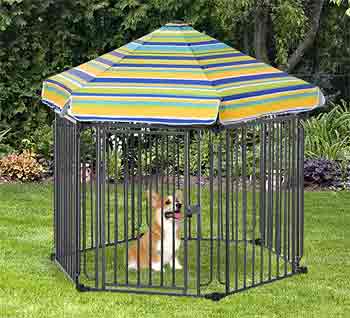
Here’s another viewer-recommended pet gazebo
This pet playpen from PawHut is designed to provide a safe and comfortable space for your lovely furry friends. It has large space for your pet to play and rest in the shade. The polyester/cloth roof cover is UV- and water-resistant to make this kennel suitable for outdoor use. Heavy-duty frame with unique designed lock adds extra security. Solid and functional, it will surely be a great addition to your backyard, patio or any outdoor or indoor space. Click on image to see more details at Amazon.com.
One reader added a rechargeable clip-on fan to keep her pups comfortable.
Keep an eye on your rig’s temperature when you’re gone with these Home Monitoring Systems.
Tips to keep your dog calm and happy while camping
-
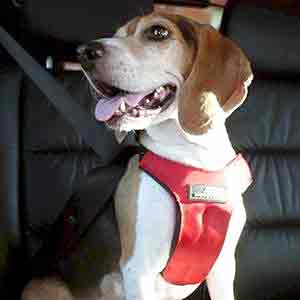
Unique Infinity Loop design, in combination with an energy absorbing padded vest, is engineered to work together to distribute and reduce damaging forces in a car accident without the need of additional hardware or attachment straps. Only harness that’s been crash tested. Click on image to see details.
Take their bed (bedding) and their favorite toy. Provide them their space. If you buy a new camping bed let them sleep in it for several days in the house before moving into the RV.
- Take them for a test drive to see how they react before you find them jumping into your lap while you’re driving down the highway. You might need a portable dog crate.
- Keep them on the same food and feeding schedule as at home.
- Always have water available, and give them ample opportunities to relieve themselves.
- Take them for walks at the same time you do when you are home.
- Do not leave them alone in a strange place for long periods.
- When traveling, keep them in a safety harness (shown here).
- Clear campsite of hazards like poisonous plants, cactus, sharp rocks, and venomous snakes.
- Provide them with good flea and tick protection.
- Bring a dog-specific first aid kit that includes their medications.
- Make sure they can manage the steps getting into your RV. Buy a lifting harness to aid their mobility if needed.
- Be mindful of hot pavement. They might need booties to protect their paws from burns.
Keeping Your Dog Cool During the Hot Summer Days
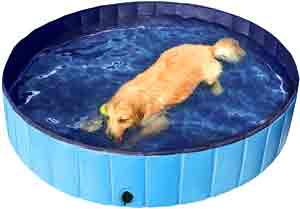 Dogs love the water. Most will eagerly jump in any pond or puddle. They get dirty and stinky. Whew. Who wants that in your camper at the end of the day? Even so, water is a great way to keep them comfortably cool on those sweltering summer days.
Dogs love the water. Most will eagerly jump in any pond or puddle. They get dirty and stinky. Whew. Who wants that in your camper at the end of the day? Even so, water is a great way to keep them comfortably cool on those sweltering summer days.
They will love a soak in clean water, but bringing a large water enclosure could be difficult. Enter the collapsible, folding doggie swimming pool. If you have water available, give them a nice cool soak. A wet dog brush is included. You might even take the opportunity to give them a bath.
You’ll need some large absorbent bath towels to dry them with and to sit on out of the dirt for several hours. Apply a couple of drop of Aura Cacia Geranium Essential oil to the base of your pup’s tail to ward off fleas and ticks. It also has a very pleasant flowery aroma.
Battery-Powered Portable Air Conditioners
Zero-Breeze makes a remarkable portable air conditioner that will run on its battery for up to 8 hours. You can snap on a second battery to double that. It will charge in about six hours when plugged into an AC outlet, and there’s a folding solar panel charger too.
Check out the brand new Mark III that has 5280 BTU of cooling power.
Unlike an evaporative cooler or the redneck icebox cooler, the Zero Breeze really works. It will cool your dog in a tent or even outside. It’s great for older dogs with health issues. The Zero Breeze helps Kelly’s dog Hank deal with Cushing’s disease.
EcoFlow Wave Portable Air Conditioner
EcoFlow also makes a portable, battery-powered air conditioner. Like the Zero Breeze, the EcoFlow Wave is a real battery-powered air-conditioner. It’s capable of producing 4000 BTU of cooling, so it’s almost twice as powerful as the ZeroBreeze. The price starts at $1,199.00* and you’ll need to pair it with an EcoFlow battery system.
See more details about these portable air conditioners as well as other ways to keep you RV cool this summer on this page: Keeping Your RV Cool This Summer
Rules to follow for Dogs in any Campground
1. Always keep your dog on a leash or under direct voice command at all times.
The “under direct voice command at all times” is a very gray area of the rule, because you really can’t keep your dog under voice command every second. A dog will bolt for a squirrel or another dog in the blink of an eye, and an altercation can ensue.
Dogs should never be running freely at a campground. One would argue that a dog should be on a leash while on a trail as well.
2. Check the rules for the campground and trails you are going to ahead of time.
Dogs aren’t allowed on the trails in Rocky Mountain National Park, for example. Visit this website to learn more about dogs in national parks. It would be a nasty shock to arrive at your destination to learn that not only is your dog not allowed on the hiking trails, neither are they are not allowed to be left alone in the campground while you hike.
3. Contain your dog, your activities, and your sounds to your campsite.
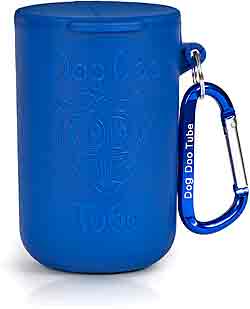
Doo Doo Tube Filled Dog Waste Bag Holder – Reusable Dog Poop Bag Tube Designed to Keep in Odors and Germs. Comes in several colors. Reasonably priced from Amazon. Click on image for details.
Assume that nobody else likes dogs, especially your dog. Many people like dogs. You like dogs. I have a dog. I like my dog. But even though a person has a dog, it doesn’t mean that they want interaction with your dog. To be a good neighbor, you must assume that no one else around you likes dogs and act accordingly.
4. Bag and dispose of your pet’s waste.
Employ the “leave no trace” ethic to dog waste, even along trails and in the outback. It despoils the environment.
I’m always incredulous when I see a dog waste bag by the side of the trail. I wonder if the hiker thinks the parks service hires someone to go around collecting the bags. No. Deliver that waste bag to a trash bin or dumpster. Doing half a job is doing no job.
If you don’t like carrying a bag of dog poop for hours, consider buying a DooDoo Tube (shown here) to keep the refuse contained until you can properly dispose of it.
5. Only bring out food at meal time.
As soon as your pet is finished eating, usually about 10 minutes, put uneaten food away and clean the dish. Do I need to explain about bears, mountain lions, coyotes, and mice?
6. Bring your pet inside your camper or RV at night.
Even if your pooch is a tough guy that patrols your yard at night, they are no match for wild predators. At the very least they will be barking in fear at everything that moves, disturbing the entire campground. Bring them in to their own bed or crate to keep them safe and calm.
7. Make sure your dog is chipped and has a collar with up-to-date contact information.
Some folks also suggest have a current photo of your dog just in case it runs away or gets lost.
See my page on dog tracking systems for more information.
Additional Tips to Make Traveling With Pets a Good Experience
Dealing With Pet Odor

Biocide Systems remove extreme odors cause by cigarettes, pets, mold & mildew, skunks, spoiled food, urine, gasoline, and more. Use this coupon code for 10% off: SHSL10
Biocide Odor Eliminator is Eco-friendly, safe for people and pets, and made in the USA.
Protect Your Screen Door
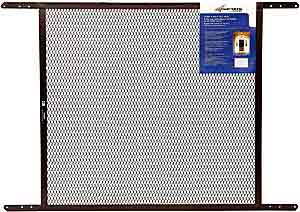
Protect your screen door from your anxious pet with a Screen Grill. This metal grill comes with the screws to install, but you might need a drill to make pilot holes for the screws. Get the right size for you door.
This RV Screen Door Grill will protect the bottom section of your screen door from dog claws and other hazards.
Click on the image to see more details and get the size that fits your door.
A Hidden Danger For Dogs
Many RVs and travel trailers have floor vents. A dog’s ID tag can get caught in one, pinning your dog to the floor. To prevent this unfortunate event, replace your dog’s ID tag with the kind that slides on their collar instead of dangling off.
It has the added benefit of not jingling when they scratch or shake during the night so you won’t be disturbed.
Professional Video Class: Traveling With Pets

In this class, instructor Dave Solberg will provide you with a thorough review of the issues relating to traveling with pets, getting ready for travel, microchipping, making your animals safe, and more!
You’ll see how to avoid problems with your pet having access to good water at campgrounds, and how to check the campgrounds looking for anything that may be dangerous for pets such as antifreeze on the ground or the dump stations.
An important aspect of camping with pets that this class will cover is pet safety. A 10-pound animal in a 50 mile-an-hour crash becomes a 500-pound projectile. That can injure not only your pet but also the humans inside the RV. We’ll talk about pet containment for motorhomes as well as trailer scenarios, and we’ll also review what types of things you need in your pet first-aid kit.
You’ll learn about places you can take your pets such as state and national parks and what type of campground regulations there may be.
Lastly, one of the biggest things that you are going to find traveling with pets is getting them accustomed to the RV lifestyle. It can be stressful for your pet to start out and to be in a new “home” environment, being in a new location, and some pets can experience motion sickness.


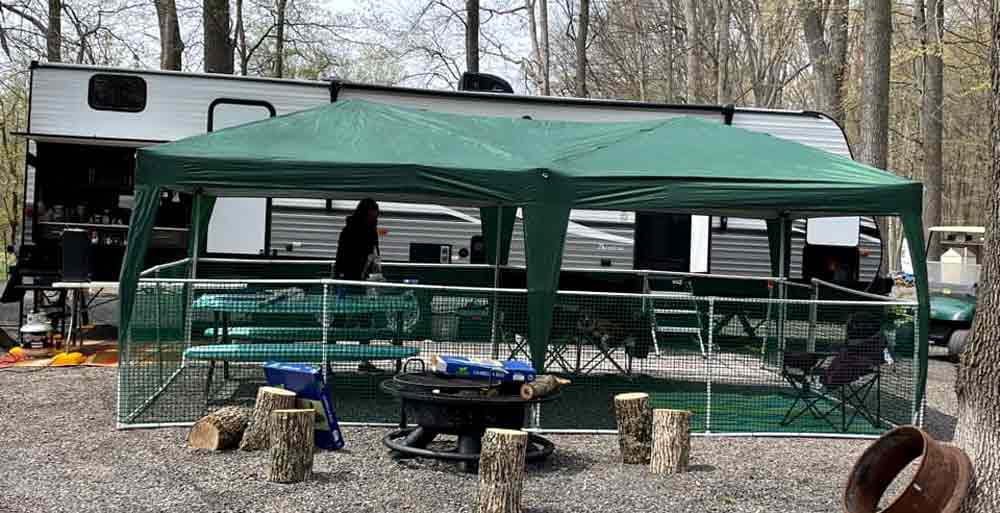
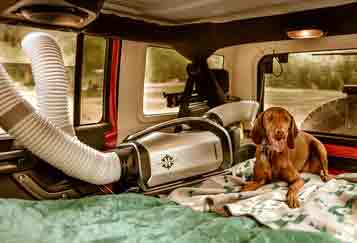
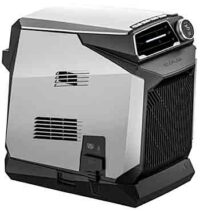
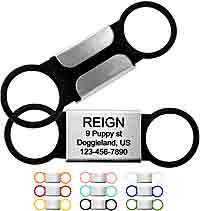


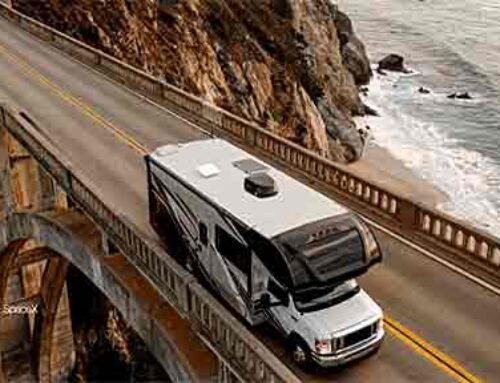

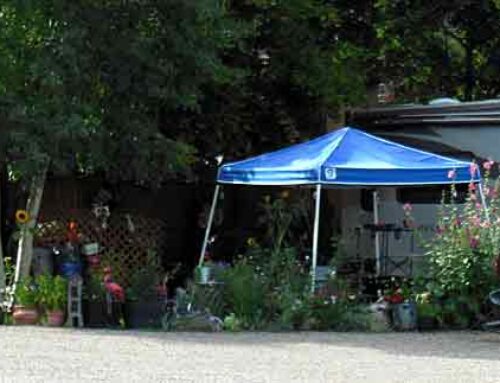
Kevin, I don’t think it’s wise to tell people to “Clear campsite of hazards like poisonous plants, cactus, sharp rocks, and venomous snakes.” They should be aware of all that but cactus and other things may be protected in some states.
Thanks Dave. I hadn’t thought of that.